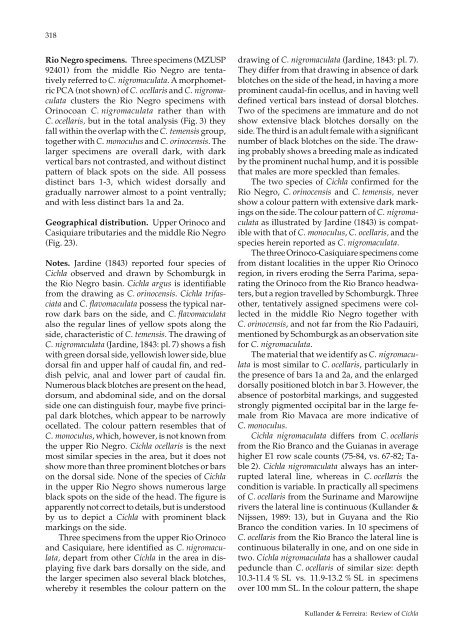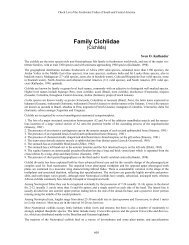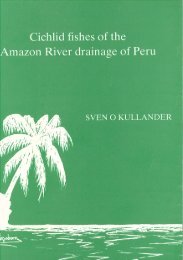Open Access PDF - Sven Kullander
Open Access PDF - Sven Kullander
Open Access PDF - Sven Kullander
Create successful ePaper yourself
Turn your PDF publications into a flip-book with our unique Google optimized e-Paper software.
318<br />
Rio Negro specimens. Three specimens (MZUSP<br />
92401) from the middle Rio Negro are tentatively<br />
referred to C. nigromaculata. A morphometric<br />
PCA (not shown) of C. ocellaris and C. nigromaculata<br />
clusters the Rio Negro specimens with<br />
Orinocoan C. nigromaculata rather than with<br />
C. ocellaris, but in the total analysis (Fig. 3) they<br />
fall within the overlap with the C. temensis group,<br />
together with C. monoculus and C. orinocensis. The<br />
larger specimens are overall dark, with dark<br />
vertical bars not contrasted, and without distinct<br />
pattern of black spots on the side. All possess<br />
distinct bars 1-3, which widest dorsally and<br />
gradually narrower almost to a point ventrally;<br />
and with less distinct bars 1a and 2a.<br />
Geographical distribution. Upper Orinoco and<br />
Casiquiare tributaries and the middle Rio Negro<br />
(Fig. 23).<br />
Notes. Jardine (1843) reported four species of<br />
Cichla observed and drawn by Schomburgk in<br />
the Rio Negro basin. Cichla argus is identifiable<br />
from the drawing as C. orinocensis. Cichla trifasciata<br />
and C. flavomaculata possess the typical narrow<br />
dark bars on the side, and C. flavomaculata<br />
also the regular lines of yellow spots along the<br />
side, characteristic of C. temensis. The drawing of<br />
C. nigromaculata (Jardine, 1843: pl. 7) shows a fish<br />
with green dorsal side, yellowish lower side, blue<br />
dorsal fin and upper half of caudal fin, and reddish<br />
pelvic, anal and lower part of caudal fin.<br />
Numerous black blotches are present on the head,<br />
dorsum, and abdominal side, and on the dorsal<br />
side one can distinguish four, maybe five principal<br />
dark blotches, which appear to be narrowly<br />
ocellated. The colour pattern resembles that of<br />
C. monoculus, which, however, is not known from<br />
the upper Rio Negro. Cichla ocellaris is the next<br />
most similar species in the area, but it does not<br />
show more than three prominent blotches or bars<br />
on the dorsal side. None of the species of Cichla<br />
in the upper Rio Negro shows numerous large<br />
black spots on the side of the head. The figure is<br />
apparently not correct to details, but is understood<br />
by us to depict a Cichla with prominent black<br />
markings on the side.<br />
Three specimens from the upper Rio Orinoco<br />
and Casiquiare, here identified as C. nigromaculata,<br />
depart from other Cichla in the area in displaying<br />
five dark bars dorsally on the side, and<br />
the larger specimen also several black blotches,<br />
whereby it resembles the colour pattern on the<br />
drawing of C. nigromaculata (Jardine, 1843: pl. 7).<br />
They differ from that drawing in absence of dark<br />
blotches on the side of the head, in having a more<br />
prominent caudal-fin ocellus, and in having well<br />
defined vertical bars instead of dorsal blotches.<br />
Two of the specimens are immature and do not<br />
show extensive black blotches dorsally on the<br />
side. The third is an adult female with a significant<br />
number of black blotches on the side. The drawing<br />
probably shows a breeding male as indicated<br />
by the prominent nuchal hump, and it is possible<br />
that males are more speckled than females.<br />
The two species of Cichla confirmed for the<br />
Rio Negro, C. orinocensis and C. temensis, never<br />
show a colour pattern with extensive dark markings<br />
on the side. The colour pattern of C. nigromaculata<br />
as illustrated by Jardine (1843) is compatible<br />
with that of C. monoculus, C. ocellaris, and the<br />
species herein reported as C. nigromaculata.<br />
The three Orinoco-Casiquiare specimens come<br />
from distant localities in the upper Rio Orinoco<br />
region, in rivers eroding the Serra Parima, separating<br />
the Orinoco from the Rio Branco headwaters,<br />
but a region travelled by Schomburgk. Three<br />
other, tentatively assigned specimens were collected<br />
in the middle Rio Negro together with<br />
C. orinocensis, and not far from the Rio Padauiri,<br />
mentioned by Schomburgk as an observation site<br />
for C. nigromaculata.<br />
The material that we identify as C. nigromaculata<br />
is most similar to C. ocellaris, particularly in<br />
the presence of bars 1a and 2a, and the enlarged<br />
dorsally positioned blotch in bar 3. However, the<br />
absence of postorbital markings, and suggested<br />
strongly pigmented occipital bar in the large female<br />
from Rio Mavaca are more indicative of<br />
C. monoculus.<br />
Cichla nigromaculata differs from C. ocellaris<br />
from the Rio Branco and the Guianas in average<br />
higher E1 row scale counts (75-84, vs. 67-82; Table<br />
2). Cichla nigromaculata always has an interrupted<br />
lateral line, whereas in C. ocellaris the<br />
condition is variable. In practically all specimens<br />
of C. ocellaris from the Suriname and Marowijne<br />
rivers the lateral line is continuous (<strong>Kullander</strong> &<br />
Nijssen, 1989: 13), but in Guyana and the Rio<br />
Branco the condition varies. In 10 specimens of<br />
C. ocellaris from the Rio Branco the lateral line is<br />
continuous bilaterally in one, and on one side in<br />
two. Cichla nigromaculata has a shallower caudal<br />
peduncle than C. ocellaris of similar size: depth<br />
10.3-11.4 % SL vs. 11.9-13.2 % SL in specimens<br />
over 100 mm SL. In the colour pattern, the shape<br />
<strong>Kullander</strong> & Ferreira: Review of Cichla




